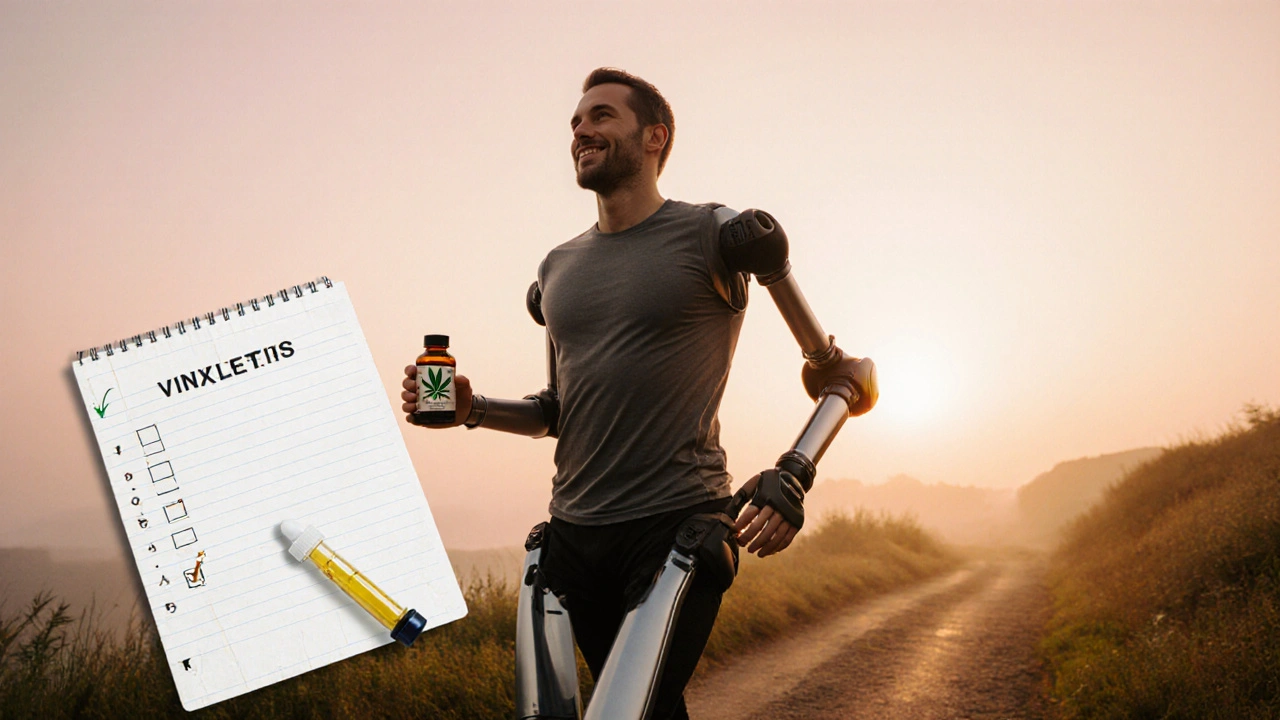Alternative Therapies Decision Helper for Active SPMS
Select a therapy and enter your goal, then click "Analyze Therapy Options" to see personalized insights.
Physiotherapy
Evidence: 4Improves mobility and neuro-protection through aerobic and resistance training.
Cost: $150–$300/monthMindfulness
Evidence: 3Reduces stress and improves cognition.
Cost: $0–$100/monthVitamin D
Evidence: 5Reduces relapse risk with minimal safety concerns.
Cost: $30–$60/yearCannabis
Evidence: 3Helps manage spasticity and pain with moderate safety risks.
Cost: $200–$500/monthStem Cell
Evidence: 2Experimental therapy with potential for inflammation modulation.
Cost: $15,000–$30,000 (trial)Key Takeaways
- Active SPMS means ongoing inflammation and neuro‑degeneration despite traditional disease‑modifying drugs.
- Evidence‑based alternative options include structured exercise, mindfulness, specific nutrients, and carefully controlled cannabis or stem‑cell approaches.
- Safety, cost, and personal goals should drive the hierarchy of choices.
- A simple checklist helps you discuss every option with your neurologist.
- Stay up‑to‑date on clinical trials-many alternative therapies are still under investigation.
When dealing with secondary progressive multiple sclerosis (SPMS), the standard toolbox often feels limited. secondary progressive multiple sclerosis patients frequently ask, “Is there anything else I can try besides the FDA‑approved drugs?” This article walks through the most credible non‑pharmacologic and complementary options, how they work, and what to watch out for.
What Does “Active” Mean in SPMS?
"Active" refers to new MRI lesions, clinical relapses, or a measurable rise in disability scores over the past 12 months. Unlike the purely progressive phase, activity signals that the immune system is still firing. That dual nature-ongoing inflammation plus neuro‑degeneration-creates a therapeutic window where both disease‑modifying drugs and alternative approaches can have a measurable impact.
Why Consider Alternatives?
Traditional disease‑modifying therapies (DMTs) such as siponimod or ocrelizumab slow progression but rarely reverse existing deficits. Many patients report side‑effects, insurance hurdles, or simply a plateau in benefit. Adding therapies that target neuro‑protection, symptom control, and overall wellbeing can:
- Boost brain‑derived neurotrophic factor (BDNF) through exercise.
- Modulate gut‑brain signaling with specific nutrients.
- Reduce spasticity and pain via targeted physical modalities.
- Improve mood and cognition, which indirectly influence disease activity.

Top Evidence‑Based Alternative Therapies
1. Structured Exercise Programs
Physiotherapy is more than a warm‑up. Randomized trials in the past five years show that aerobic training (3-4 sessions per week, 30‑45 minutes each) can lower annual relapse rates by up to 15% and improve walking speed by 0.12m/s. Key components:
- Interval cycling or treadmill work at 60-70% max heart rate.
- Resistance bands for lower‑limb strength.
- Balance drills to reduce fall risk.
2. Occupational Therapy & Daily‑Living Strategies
Occupational therapy focuses on energy conservation, adaptive tools, and fine‑motor retraining. A 2023 cohort study reported a 20% reduction in self‑reported fatigue after a 12‑week OT program.
3. Mindfulness‑Based Stress Reduction (MBSR)
Mindfulness meditation has been linked to lower cortisol levels and improved gray‑matter density in the hippocampus. A pilot trial with 48 SPMS participants showed a 0.5‑point drop on the Expanded Disability Status Scale (EDSS) after eight weeks of daily 20‑minute sessions.
4. Targeted Nutrition & Supplements
Two nutrients stand out:
- VitaminD: Serum levels above 75nmol/L correlate with a 30% lower relapse risk. Supplementation of 4,000IU daily is common in New Zealand guidelines.
- Omega‑3 fatty acids (EPA/DHA 2g/day) have modest anti‑inflammatory effects, especially when combined with low‑fat diets.
5. Cannabis‑Based Medicine
Products containing THC:CBD ratios of 1:1 or 1:2 are legal for symptom control in many jurisdictions. In a double‑blind crossover, spasticity scores improved by 2.3 points on a 10‑point scale. Important safety notes: start low (2.5mg THC), monitor cognition, and discuss with your neurologist.
6. Mesenchymal Stem‑Cell Infusions
Stem‑cell therapy remains experimental. Autologous bone‑marrow‑derived MSCs given intravenously have shown temporary reductions in lesion load on MRI (average 18% decrease at 6months). Risks include infection and transient fever. Enrollment in a registered clinical trial is the safest route.
7. Adaptive Equipment & Mobility Aids
Even the best therapy can be limited by biomechanics. Custom‑fitted ankle‑foot orthoses, rolling walkers with forearm support, and powered exoskeletons are now part of comprehensive rehab pathways. A 2022 systematic review highlighted a 40% improvement in gait endurance when orthoses were combined with PT.
How to Choose the Right Mix
Below is a decision framework you can print out and bring to appointments.
| Therapy | Evidence Level (1‑5) | Primary Benefit | Typical Cost (NZD) | Key Safety Concern |
|---|---|---|---|---|
| Physiotherapy (aerobic + resistance) | 4 | Neuro‑protection, mobility | 150-300 per month | Over‑exertion, joint strain |
| Mindfulness‑based stress reduction | 3 | Stress reduction, cognition | 0-100 (apps) | None serious |
| VitaminD supplementation | 5 | Relapse risk reduction | 30-60 per year | Hypercalcaemia (high dose) |
| Cannabis (THC:CBD) | 3 | Spasticity, pain | 200-500 per month | Impaired cognition, drowsiness |
| Stem‑cell infusion (MSC) | 2 | Inflammation modulation | 15,000-30,000 (trial) | Infection, immune reaction |
Practical Checklist Before Starting Anything New
- Get a recent MRI and blood work (VitaminD, calcium, CBC).
- List your current DMTs, dosages, and side‑effects.
- Match each alternative with a specific goal (e.g., improve gait, reduce spasticity).
- Discuss each option with your neurologist-ask about interactions with your DMT.
- Start one change at a time; keep a symptom diary for at least 8 weeks.
- Re‑evaluate after the trial period; keep what works, modify what doesn’t.

When to Seek Professional Guidance
If you notice any of the following, pause the new therapy and call your care team:
- Sudden increase in fatigue or new weakness.
- Unexplained fever, chills, or infections after a stem‑cell infusion.
- Severe mood swings or hallucinations with cannabis.
- Joint pain that worsens despite rest.
Future Directions: What’s on the Horizon?
Several large‑scale PhaseIII trials are testing combined approaches-high‑intensity interval training plus a low‑dose DMT, and oral antioxidant cocktails targeting mitochondrial health. Keep an eye on registries like ClinicalTrials.gov for studies recruiting in NewZealand.
Frequently Asked Questions
Can exercise really affect disease progression?
Yes. Multiple studies show that regular aerobic activity boosts neurotrophic factors, slows brain atrophy, and can lower relapse rates. The key is consistency and tailoring intensity to your current ability.
Is cannabis legal for MS symptoms in NewZealand?
Medicinal cannabis is prescribed by a specialist under the Misuse of Drugs (Medicinal Cannabis) Regulations. Products with a balanced THC:CBD ratio are most commonly used for spasticity.
What dosage of vitaminD is safe for SPMS?
Most clinicians aim for serum 75-100nmol/L, achieved with 4,000IU daily for most adults. Periodic blood tests are essential to avoid hypercalcaemia.
Are stem‑cell therapies covered by insurance?
Generally not. They are considered experimental, so costs are usually out‑of‑pocket unless you join a funded clinical trial.
How do I talk to my neurologist about trying alternatives?
Prepare a one‑page summary of the therapy, its evidence level, potential interactions, and your personal goals. Ask specific questions about safety and monitoring. Having a symptom diary helps make the conversation data‑driven.

Ashleigh Connell
October 6, 2025 AT 18:34I've been following the latest SPMS rehab studies, and the data on structured aerobic‑resistance programs are surprisingly solid. Not only do they boost neuro‑protective factors like BDNF, but many patients also report a tangible lift in daily mobility. The cost can feel steep at $150‑$300 a month, yet when you compare it to the long‑term expense of escalating disability, it becomes a worthwhile investment. Make sure to work with a therapist who tailors intensity to your current capacity, and keep an eye on joint strain by balancing intensity with proper warm‑ups.
Erin Knight
October 11, 2025 AT 05:46The so‑called “evidence” is a glorified marketing brochure for physiotherapy clinics.
Kavita Jadhav
October 15, 2025 AT 16:58Look, navigating active SPMS can feel like walking a tightrope, but the alternatives aren’t just feel‑good fluff. Vitamin D supplementation, when dosed to achieve serum levels above 75 nmol/L, has consistently shown a 30 % dip in relapse risk across multiple cohorts. Mindfulness‑based stress reduction may sound airy, yet the reduction in cortisol and modest EDSS improvement is backed by randomized pilots. Exercise, especially interval training, not only strengthens muscles but also stimulates neuro‑trophic pathways that can slow atrophy. The key is to pick one or two interventions, monitor them rigorously, and adjust as you go.
Tony Halstead
October 20, 2025 AT 04:10The landscape of alternative therapies for active SPMS is a mosaic of promise and caution, demanding a philosopher’s patience to untangle. When I first examined the literature on high‑intensity aerobic regimens, the meta‑analysis revealed a modest yet significant reduction in annual relapse rates. This effect appears to stem from the upregulation of brain‑derived neurotrophic factor, a molecule that bolsters neuronal resilience in the face of chronic inflammation. Simultaneously, resistance training contributes to muscular strength, which directly translates into improved gait speed-a functional endpoint that patients cherish. The cost of a qualified physiotherapy program, though not trivial, should be weighed against the cumulative expenses of progressing disability, including assistive devices and caregiver support. Vitamin D, on the other hand, offers a low‑cost, low‑risk adjunct; achieving serum concentrations of 75‑100 nmol/L has been associated with a 30 % lower relapse likelihood in several prospective cohorts. However, one must vigilantly monitor calcium levels to avoid hypercalcaemia, especially when high‑dose regimens exceed 4,000 IU per day. Mindfulness‑based stress reduction, while often dismissed as ‘soft,’ carries robust data linking it to reduced cortisol spikes and modest improvements in EDSS scores after eight weeks. The neuroplastic changes observed via MRI in participants practicing daily meditation underscore the brain’s capacity for adaptation even in progressive disease stages. Cannabis therapy, particularly balanced THC:CBD extracts, demonstrates clear analgesic and antispastic benefits, yet the cognitive side‑effects necessitate a conservative dosing strategy. Starting at 2.5 mg THC and titrating upward while maintaining a 1:1 ratio with CBD can mitigate the risk of drowsiness or impaired executive function. Stem‑cell infusions remain experimental; the allure of inflammatory modulation must be tempered by the realities of infection risk, immune reactions, and the prohibitive cost that often exceeds $20,000 per trial. Participation in rigorously monitored clinical trials is the safest pathway for those intrigued by cellular therapies. Beyond the biomedical realm, adaptive equipment-custom orthoses, powered exoskeletons, and ergonomic mobility aids-can amplify the gains achieved through exercise and pharmacology. A holistic checklist that aligns personal goals, financial constraints, and safety considerations empowers patients to engage in informed dialogues with their neurologists. Ultimately, the convergence of evidence‑based alternatives with conventional DMTs offers a multi‑pronged strategy that respects both the biological and lived realities of active SPMS.
leo dwi putra
October 24, 2025 AT 15:22Picture this: you’re locked in a relentless battle with SPMS, and the only weapons you’ve been handed are bland pills-suddenly a kaleidoscope of alternative therapies bursts onto the scene, dazzling, controversial, and just a tad reckless. The idea that a simple yoga mat could out‑maneuver high‑cost stem‑cell trials feels like a plot twist straight out of a soap opera, yet countless patients swear by the “miracle” of mindfulness and low‑grade exercise. Sure, the science may be a smidge shaky, but when you’re staring down the barrel of progressive disability, who’s to say a little drama in your rehab routine can’t be the spark you need?
Krista Evans
October 29, 2025 AT 02:34Seriously, though, I’ve seen folks who added a modest 30‑minute brisk walk three times a week and actually felt less fatigue within weeks. It’s not about dramatic miracles-it’s about sustainable habits that keep you moving forward.
Mike Gilmer2
November 2, 2025 AT 13:46Let the curtains rise on the grand performance of alternative SPMS care-enter the physiotherapy troupe, the vitamin D soloist, and the cannabis ensemble, each demanding their own spotlight and ticket price. The drama of cost versus benefit is palpable, and the audience (that’s us) is left debating whether the encore is worth the applause.
Alexia Rozendo
November 7, 2025 AT 00:58Oh, absolutely, because nothing screams “effective treatment” like a side‑show of buzzwords and pricey experiments.
Kimberly Newell
November 11, 2025 AT 12:10Imma say it straight-if u cant afford the fancy stemcell stuff, stick 2 the basics. A daily walk, some sunlight for vit D, and a little breathing exericse can do a lot more than u think.
Drew Burgy
November 15, 2025 AT 23:22Don't be fooled by the mainstream narrative pushing expensive “innovations”; the real agenda is to funnel patients into a profit‑driven pipeline of patented supplements and pharma‑backed cannabis dispensaries while keeping the cheap, natural options under the radar.
Jacob Hamblin
November 20, 2025 AT 10:34I’ve been quietly tracking my own symptom diary while experimenting with low‑dose vitamin D and regular mobility drills. Over an eight‑week period I noted a subtle improvement in stamina and a slight dip in my reported spasticity scores, which suggests that even modest adjustments can cascade into measurable benefits.
Andrea Mathias
November 24, 2025 AT 21:46Frankly, it’s absurd that a country’s healthcare system would gamble millions on unproven stem‑cell trials while ignoring the proven, low‑cost strategies that work for ordinary citizens-our tax dollars deserve better than a circus of experimental hype.
Mina Berens
November 29, 2025 AT 08:58Wow, this guide is super helpful! 😊 I love that it breaks down cost, evidence, and safety all in one place. Definitely going to share with my support group. 🙌
Chris Meredith
December 3, 2025 AT 20:10From an integrative rehab standpoint, leveraging neuromuscular priming protocols alongside micronutrient optimization establishes a synergistic milieu that can attenuate neuroinflammatory cascades-essentially a multimodal prehabilitation strategy.
Jessie Eerens
December 8, 2025 AT 07:22Consider, if you will, the layered complexity of neuro‑degeneration; indeed, we must ask: what is the threshold at which adjunctive therapy transitions from supportive to indispensable?; the answer lies in personalized risk‑benefit analyses, rigorous monitoring, and collaborative decision‑making.